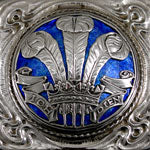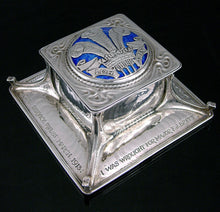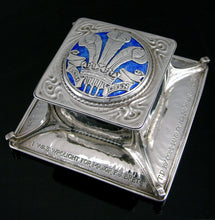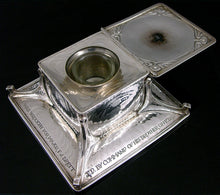Prince of Wales’s Own Civil Service Rifles Presentation Inkwell, 1912
Adding product to your cart
Hallmarked London 1912
Measurements: 14cm (5.5ins) square
Designed in the Arts & Crafts style, the presentation inkwell is square in form with four applied buttresses at the corners, the hinged cover with the plumes, crown and motto of the Prince of Wales on mottled blue enamelled ground, with hammered finish, marked near edge and inside cover, the base chased 'OMAR RAMSDEN ET ALWYN CARR ME FECERUNT'. The inscription reads 'I Was Wrought for Major F. J. Brett T. D. by Command of His Brother Officers of The Prince of Wales's Own Civil Service Rifles: March 1913'
Read more
The Civil Service Rifles originated with the Bank of England Volunteers, a unit raised during the French invasion scares of the 1790’s. The regiment was reformed in 1860and in 1908 transferred to the Territorial Force under the title of 15th (County of London) Battalion, The London Regiment (Prince of Wales's Own, Civil Service Rifles). The regiment was composed of volunteers employed in Civil Service departments of the the Audit Office, Post Office, Inland Revenue offices in Somerset House, and Whitehall. Regimental headquarters and companies were based at Somerset House.During the First World War the regiment was expanded to three battalions which fought in France and Flanders, Macedonia, and the Near East. Among those conscripted into the regiment was the sculptor Henry Moore. A memorial to the fallen of the Civil Service Rifles was designed by Sir Edwin Lutyens and stands at Somerset House.
Major Brett was a fencing enthusiast and was formerly the commander of the Post Office Savings Bank Messengers Drilling Corps. He retired from the Civil Service Rifles in April 1912 but was recalled to active service with the London Regiment in October 1914.
Omar Ramsden (1873-1939) & Alwyn Carr (d.1940)
Born in Sheffield, Ramsden spent some years in America where his father worked as a manufacturer of electro-plated goods. In 1887 he was apprenticed to a Sheffield silversmith and in 1890 attended the Sheffield School of Art where he met his future business partner Alwyn Carr. Carr and Ramsden won Sheffield Corporation Scholarships in 1893 and 1894 respectively and together they attended summer classes at the Royal College of Art. Having won the prestigious commission to design and make the City of Sheffield ceremonial mace in 1897, Ramsden established a studio with Carr in London in 1898, occupying premises in Chelsea and Fulham until 1918 when the partnership was formally dissolved. On the outbreak of war in 1914 Carr enlisted in the Artists’ Rifles and was commissioned serving as a captain in the R.A.S.C. on the Western Front from which he was invalided in 1918.








